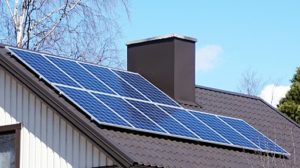What are solar kWh? How do they relate to solar kW? And how can you apply this information to calculate the size and cost of the solar power system your home needs? Our solar panel guide will give you solid, foundational knowledge to answer these questions.
 Solar installation professionals will reference 2 kW systems, 6 kW systems, etc, and their respective costs. How will you know what size system is suitable for your household? Before you get in touch with a solar installer, you’ll want to learn some basic facts and terminology.
Solar installation professionals will reference 2 kW systems, 6 kW systems, etc, and their respective costs. How will you know what size system is suitable for your household? Before you get in touch with a solar installer, you’ll want to learn some basic facts and terminology.
Learn how to plan for a solar installation that will cover all your household’s energy needs, without overpaying for a system that’s larger than necessary. This process starts with looking at average kWh per household and working out how this might compare to your home. Once you’ve read this solar panel guide, you can estimate your installation cost using real data on home solar panel installations in the U.S.
- What is a Solar kW?
- What are Solar kWh?
- Average kWh in the U.S.
- Using Solar kWh to Determine System Size
- Solar Panel Guide to Estimating Costs
What is a solar kW?
Home solar power is measured in units of kilowatts (kW). A kW is a measurement of power. Watts are typically used to label lightbulbs, for example, such as 30w or 60w. Watts are a small amount of power, while a kilowatt is equal to one thousand watts.
How do kW relate to the size of a solar power system? You might think the kW tells you the amount of energy the system generates. But that’s not quite right. The kW size actually describes how much power your system can produce under ideal conditions with an hour of maximum sunlight. For example, a 2 kW system can generate a maximum of two kilowatts in an hour. Whereas, a 6 kW system generates up to sox kilowatts in an hour.
In real world application, though, most solar power systems won’t actually produce their maximum kW per hour. Weather, dust, and other conditions affect solar panel performance. So a kW size is not necessarily a guarantee, just a way of describing maximum performance. While the kW number isn’t an exact figure for the power your solar panel system can generate, it is the fundamental benchmark used to compare solar power systems. Even under less-than-ideal conditions, a high kW system will produce more energy from sunshine than a low kW system.
What are solar kWh?
 What about solar kWh (“kilowatt-hours”)? How does this term relate to kW? Well, just as kW is based on the maximum power a system can generate, kWh are based on how much energy actually gets used. You might have seen kWh noted on your electricity bills.
What about solar kWh (“kilowatt-hours”)? How does this term relate to kW? Well, just as kW is based on the maximum power a system can generate, kWh are based on how much energy actually gets used. You might have seen kWh noted on your electricity bills.
A number of kWh means that a system will burn a kW over an hour. A 1 kWh appliance, for example, would use a kW of energy in one hour.
Average kWh in the U.S.
Let’s tie these concepts to some real-world numbers. Average households in the U.S. burned 10,649 kWh in the year 2019.[1]US Energy Information Administration, 2020 On average, that comes out to around 29 kWh per day, or 877 kWh per month, for each household.
Using those averages, we can conclude that most homes burned a little more than a kW of power during each hour in the day. In that case, could a 1 kW or 2 kW solar power system be enough to power those homes? The reality isn’t that clear-cut, unfortunately. To get accurate numbers, you’ll have to consider not only average use but the maximum use: how much energy does a home need in peak hours or seasons?
Your monthly electricity bills should state how many kWh you are using. If your home has a SmartMeter, you might even have online access to nuanced tracking data about your power use. That information will be very helpful. You’ll want to find out not only how much power you’re using overall, but how much power your household uses when its power consumption is at peak levels.
Your power usage varies across different months. Homeowners typically will see their energy bills ebb and flow throughout the year, depending on seasonal temperatures. You’ll want to make sure your solar installation can power your home during its most intense periods for heating and cooling. And you’ll need to take this into account when estimating the right size system for your home solar.
So, look at the past year of power usage for your household to get accurate data for your calculations. Once you know your required kWh, speak with solar installers in your area. Compare quotes and ask them for information on ratios of kW to kWh in your area.
Using Solar kWh to Determine System Size
What number of solar kWh can a 2 kW system, or a 6 kW system, actually generate for you? There’s no simple answer: in fact, this can vary drastically depending on where your home is located. The output of home solar panels can vary by over 25% depending on geography!
 As an example, let’s look at the Pacific Northwest. West of the Cascades, a 1 kW system can generate around 1,000 kWh in a year. But the same exact system east of the Cascades will produces 1,250 kWh in a year.[2]Washington State University, 2009 You’ll need an expert solar installer to evaluate your land with regard to its elevation, shade, and other factors that affect its kWh efficiency.
As an example, let’s look at the Pacific Northwest. West of the Cascades, a 1 kW system can generate around 1,000 kWh in a year. But the same exact system east of the Cascades will produces 1,250 kWh in a year.[2]Washington State University, 2009 You’ll need an expert solar installer to evaluate your land with regard to its elevation, shade, and other factors that affect its kWh efficiency.
Before you can get an accurate quote for solar installation, your installer will need to know how many kWh your household needs during peak usage. But that’s not the only important variable. Your installer will also need to look at the specifics of your home, such as available roof area and where your house is situated on your plot. (Your available roof area will also help you and your installer decide which solar panel types to install.)
But even before getting into an in-depth conversation with a professional, wouldn’t it be helpful to get a rough estimate for your solar installation right now? You can take everything you’ve learned in our solar panel guide and use it to estimate your costs right now.
Solar Panel Guide to Estimating Costs
It’s true there is a lot of variation in solar kWh generated by systems of the same kW size, as we’ve seen. However, by far the majority of home solar power systems land in the range of 3 kW to 6 kW. If your home is on the smaller side, in a region with lots of sunshine, your home will probably fall on the lower end of this range. If your home is larger than average, and/or in an area with less sunlight, you’ll probably be looking towards the higher end of that range. With this in mind, you can definitely make an informed guess.
With a rough number for the size of solar system you need, you can start to estimate your solar panel cost right now!
(Photographs: Jyväskylä solar panels by Tiia Monto, licensed under CC BY-SA 4.0. Cascade Mountains seen from Lake Stevens by Ron Clausen, licensed under CC BY-SA 4.0. Illustration: Electricity by Gregor Cresnar from the Noun Project.)
References
